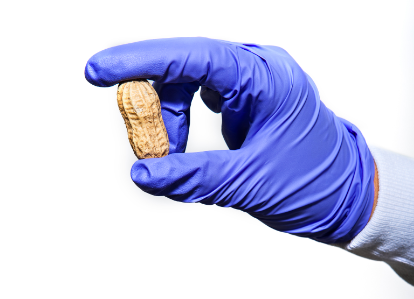 By Rozlyn Boutin, Department of Neuroscience, Carleton University
By Rozlyn Boutin, Department of Neuroscience, Carleton University
In today’s society, it seems as though things like “peanut-free zones” and gluten-free menus are popping up all over the place. Even if you yourself don’t have an allergy, you probably know of at least one person that does. Over the past few decades, affluent westernized countries like Canada have seen an alarming increase in the prevalence of allergic diseases and are now facing an “allergy epidemic” (Prescott and Allen, 2011). Of particular concern is the rise of food allergies such as peanut allergies. These can elicit life-threatening immune responses and are rarely outgrown. Given how quickly rates of food allergies have skyrocketed in westernized countries, it seems that environmental factors, rather than genetics, are likely at fault.
Current research in this area has focused on how the increased hygiene measures adopted in affluent countries might be contributing to the recent increase in allergy prevalence. It has been proposed that these improved hygiene measures may be altering the normal process of colonization of the human body by microbes that live in symbiosis with their hosts and, under normal conditions, represent an important part of human physiology and immunity. Thus, although the high standards of hygiene and sanitation maintained by Canadians have undoubtedly played an important role in curbing the spread of devastating infectious diseases, we may be inadvertently tipping the balance of health from acute infectious diseases to chronic autoimmune and allergic diseases by taking these hygiene practices too far.

Beginning at birth and continuing until around the time that weaning is complete, an infant’s body is colonized by microbes naturally found in the environment, such as on the skin of their mothers and in the food that they eat (Eggesbo et al., 2003). In fact, bacterial cells within the body outnumber human cells by a factor of 10 and help with normal physiological processes such as the digestion of certain foods, production of vitamins, nutrient absorption, and resistance to pathogenic microorganisms. The composition of this microbial community is affected my many things, including birth order, birth method, having a family pet, living on a farm, and diet (Kuo et al., 2013; Penders et al., 2006). In the gut, the naturally occurring microorganisms that live in harmony with human cells are collectively termed the ‘gut microflora’ and also play a central role in immunity, with many effects on the development of immune cell populations implicated in the development of allergies. Thus, it has been suggested that the disruption of this microbial community within the gut early in life through hygiene and other practices that limit microbial exposure may alter immune responses.

Another common practice in westernized countries that can alter the community of microbes living in the intestinal tract is the use of antibiotics and their administration to infants. Antibiotic administration to children has increased in recent years in developed countries more than in developing countries, paralleling the observed increase in the prevalence of allergic diseases seen primarily in affluent countries. For example, antibiotics are increasingly prescribed to children for ailments such as the common cold, bronchitis, and upper respiratory tract infections, despite the fact that some of these illnesses do not actually respond well to antibiotics (Nyquist et al., 1998). Even in cases where a bacterial infection is the cause of an illness, antibiotic drugs affect not only the potential causative agent of the initial infection for which an individual sought medical attention, but also many other species of “good” bacteria living in harmony within the host. Some of these species inhabit the intestinal tract, where they act to favourably modulate the normal immune response to common allergens and prevent allergy (Cao et al., 2014; Stefka et al., 2014). As a result, if the population of bacteria within the intestinal tract is altered or abolished by antibiotic use or other hygienic practices, it may follow that the immune system of the host will respond abnormally to innocuous (harmless) antigens, such as those from peanuts.
Several population-based studies have looked at the associations between perinatal antibiotic use and the later development of allergy. However, the vast array of factors that can alter the normal colonization pattern of the intestinal tract by microbes make it very difficult to tease apart which factors are having the greatest influence and are truly causing differences in immune responses. Thus, experimental methods in model species (e.g. rodents) provide a means to uncover how antibiotic use is linked to allergies, and to determine causal relationships.
 The Peanut Project
The Peanut Project
The aim of our “peanut project” was therefore to develop a mouse model of peanut allergy that recapitulates some of the aspects of human allergies. We then wanted to use this model to begin to experimentally characterize how antibiotic use may be altering the composition of the gut microflora to thereby influence the development of peanut allergies. Although we faced several hurdles along the way, we successfully developed a new way of inducing a peanut allergy in mice that mimics certain aspects of allergy used as diagnostic tools by clinicians. Once this model was developed, we bred mice in the lab and exposed newborn mice to the broad-spectrum antibiotic vancomycin for six weeks to manipulate the normal colonization pattern of their intestinal tracts. We monitored differences in the microbial contents of the intestinal tracts of these mice and of mice reared on tap water by analyzing the bacterial RNA content of fecal samples taken from the mice throughout this time period. Once they were six weeks old, we then induced a peanut allergy in the mice to determine whether antibiotic exposure was associated with exacerbated allergic phenotypes later in life. We found that the microbial communities within the guts of the mice treated with the antibiotic differed drastically from those of mice reared on regular water and that the antibiotic-treated mice showed some increases in the severity of certain allergic outcomes in response to peanut butter. These data suggest that the antibiotic treatment killed off or prevented some of the “good” bugs in the environment from colonizing the guts of the antibiotic-treated mice, which is consistent with alteration of the ability of the immune systems of these mice in responding to peanut butter.
Thus, like many things, it appears as though the harms and benefits of being exposed to microbes are not black and white, and that the adage that “bacteria are bad” perhaps paints an overly simplistic and somewhat misleading view of how we should think about hygienic practices.
Based on Presentation by Shawn Hayley and Rozlyn Boutin on April 8, 2015 at The Science Cafe, Carleton University, Ottawa, ON.
The Peanut Project investigators include Rozlyn Boutin, Shawn Hayley, Mark Forbes, and Zach Dwyer at Carleton University, Canada.
Baby Image courtesy of Serge Bertasius Photography at FreeDigitalPhotos.net
Pill image courtesy of ddpavumba at FreeDigitalPhotos.net